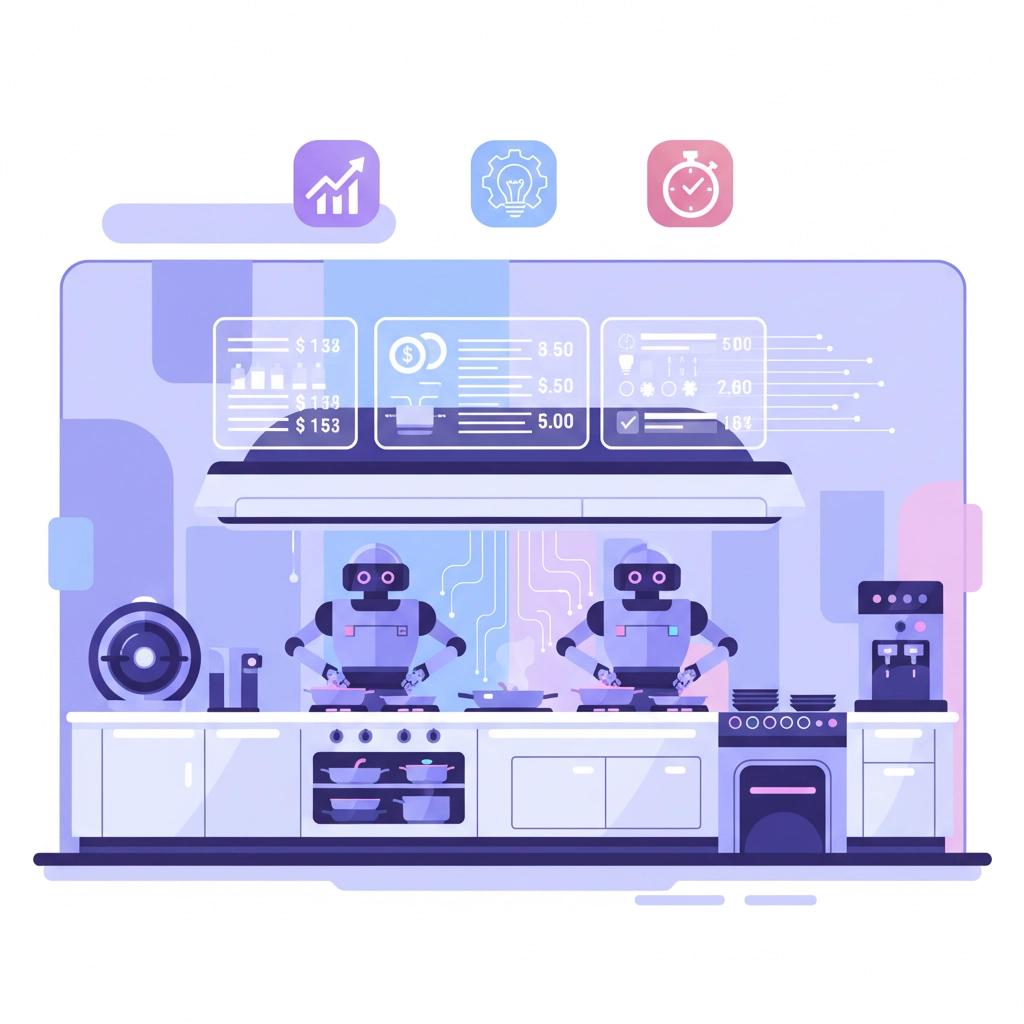How AI Tax Breaks Can Save Your Restaurant Big Money in 2025
- Jayme Lin Rose

- Oct 16
- 5 min read
Running a restaurant in 2025 means dealing with rising labor costs, high turnover rates, and shrinking profit margins. But here's some good news: the government is practically paying you to upgrade to AI technology. Between massive tax deductions and the real-world savings from automation, smart restaurant owners are cutting their tax bills while boosting their bottom line.
Let me walk you through exactly how these tax breaks work and why investing in AI might be the smartest financial move you make this year.
The Big Picture: What's Changed in 2025
The tax landscape for restaurant technology investments has never been better. We're talking about immediate write-offs that can put thousands of dollars back in your pocket right away. The key is understanding which AI investments qualify and how to structure your purchases for maximum benefit.
The two biggest opportunities are the Section 179 deduction and 100% bonus depreciation. Both let you deduct the full cost of qualifying equipment in the year you buy it, instead of spreading those deductions over several years like traditional depreciation.
Section 179: Your Immediate Tax Relief

Here's where things get interesting. The Section 179 deduction for 2025 allows you to immediately write off up to $1,160,000 in qualifying equipment purchases. AI software and hardware systems often qualify as business equipment eligible for this immediate deduction.
Think about it this way: if you invest $50,000 in an AI phone system, kitchen automation, and customer service bots, you can deduct that entire amount on your 2025 tax return. At a 25% effective tax rate, that's $12,500 in immediate tax savings. Your net investment drops to $37,500, and you still get all the operational benefits of the AI system.
The best part? This isn't a credit that phases out or gets complicated. It's a straight deduction that reduces your taxable income dollar for dollar.
100% Bonus Depreciation: Double Down on Savings
On top of Section 179, restaurants can take advantage of 100% bonus depreciation for qualified property placed in service after January 19, 2025. This applies to kitchen equipment, bar systems, and integrated AI hardware that becomes part of your restaurant's operational infrastructure.
Here's a real example: Let's say you install a $30,000 robotic server system. You can immediately deduct the full purchase price under bonus depreciation rules. If you're in a 25% tax bracket, you save $7,500 on your tax bill right away.
The beauty of these provisions is that they work together. You can use Section 179 for some purchases and bonus depreciation for others, maximizing your first-year deductions across different types of AI investments.
Robot Servers vs. Human Servers: The Real Numbers

Let's break down the actual costs of a robot server compared to a human employee, including all the tax implications:
Human Server Annual Costs:
Base salary: $35,000
Payroll taxes (employer portion): $2,678
Workers' compensation insurance: $700
Health insurance contribution: $6,000
Paid time off and sick days: $2,800
Training and onboarding costs: $1,500
Hiring and recruitment: $800
Total annual cost: $48,478
Robot Server Investment:
Initial purchase price: $45,000
Annual maintenance: $2,500
Software updates: $1,200
Total first-year cost: $48,700
At first glance, the costs look similar. But here's where the tax benefits kick in:
With Section 179, you deduct the full $45,000 robot cost immediately. At a 25% tax rate, that's $11,250 back in your pocket. Your effective first-year cost for the robot drops to $37,450 ($48,700 - $11,250).
Meanwhile, you can't deduct the full cost of your human employee immediately. You pay payroll taxes quarterly and deduct wages as you pay them throughout the year.
Year two and beyond: The robot's annual operating cost stays around $3,700 (maintenance and software), while your human employee costs continue at $48,478 annually, increasing with wage inflation.
Strategic Timing for Maximum Benefits
The timing of your AI purchases matters for tax purposes. Since both Section 179 and bonus depreciation apply to equipment "placed in service" during the tax year, you want to have your systems up and running before December 31st to claim the deductions.
Here's a smart approach: Plan your AI investments in Q3 or early Q4. This gives you time to implement the systems, train your staff, and ensure everything is operational before year-end. You get the full tax benefit while having most of the year to see operational improvements.
Beyond Servers: Other AI Investments That Qualify

Don't limit your thinking to robot servers. Other AI technologies that typically qualify for these tax benefits include:
Kitchen Automation Systems: AI-powered cooking equipment, inventory management systems, and food safety monitoring that optimize operations and reduce waste.
Customer Service AI: Chatbots, voice ordering systems, and reservation management platforms that handle customer interactions 24/7.
Predictive Analytics Platforms: Systems that forecast demand, optimize staffing levels, and manage inventory based on historical data and trends.
Payment and POS Integration: AI-enhanced point-of-sale systems that provide insights into customer behavior, menu optimization, and fraud prevention.
Each of these investments can potentially qualify for immediate tax deductions while delivering ongoing operational benefits.
Additional Incentives to Consider
Beyond federal tax benefits, many states and localities offer additional incentives for businesses adopting AI technology. Some utility companies provide rebates for energy-efficient AI systems that optimize resource usage.
Research and development tax credits may also apply if you're customizing AI solutions for your specific restaurant needs or developing new applications for existing technology.
Making the Numbers Work for You

Here's how a typical restaurant might approach an AI investment strategy:
Phase 1 - Customer Interface ($25,000):
AI phone system and reservation management
Immediate Section 179 deduction: $25,000
Tax savings at 25% rate: $6,250
Net cost: $18,750
Phase 2 - Kitchen Automation ($35,000):
Inventory management and cooking optimization
Bonus depreciation deduction: $35,000
Tax savings at 25% rate: $8,750
Net cost: $26,250
Phase 3 - Service Automation ($45,000):
Robot servers and dining room management
Section 179 deduction: $45,000
Tax savings at 25% rate: $11,250
Net cost: $33,750
Total investment: $105,000 Total tax savings: $26,250 Net investment: $78,750
The operational savings from reduced labor costs, improved efficiency, and increased customer satisfaction typically pay for the net investment within 18-24 months.
Working with Professionals
While these tax benefits are substantial, the rules can be complex. Work with a qualified tax professional who understands both restaurant operations and technology investments. They can help you structure purchases for maximum benefit and ensure you're taking advantage of all available deductions.
Document everything properly. Keep detailed records of purchase dates, implementation timelines, and how each AI system integrates with your business operations. This documentation supports your deduction claims and demonstrates the business purpose of your investments.
The Bottom Line: Why 2025 Is Your Year
The combination of generous tax deductions and proven AI ROI makes 2025 the perfect time to modernize your restaurant operations. You're not just buying technology – you're making a tax-advantaged investment that reduces your current tax liability while building a more efficient, profitable business.
The restaurant industry is evolving rapidly. Early adopters of AI technology gain competitive advantages that become harder to replicate over time. With the government essentially subsidizing your transition through these tax benefits, the risk of investment drops significantly while the potential rewards increase.
Ready to explore how AI can transform your restaurant while cutting your tax bill? Contact us to discuss your specific situation and develop a strategic implementation plan that maximizes both your operational improvements and tax savings.
Comments